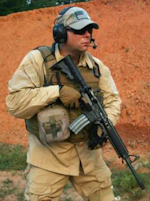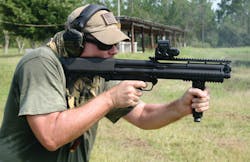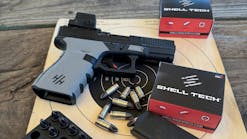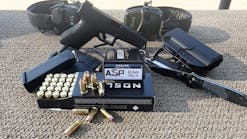Historically the fighting shotgun has more often than not been merely a converted sporting gun modified slightly for duty use. There have been exceptions, of course, the SPAS-12 and the USAS-12 come immediately to mind as does the Striker from South Africa. Despite mechanical and capacity advantages over converted fowling pieces, none of the above ever caught on with the American law enforcement community.
KelTec KSG
Once known only for inexpensive, polymer framed pistols, KelTec has given their image a facelift during the last few years. The .308 Winchester RFB turned the gun world on its head by offering a .308 semi-automatic rifle that was as compact as an M4. This year they turned the shotgun world on its head by introducing the KSG (KelTec ShotGun).
Capitalizing on his bull-pup success, George Kelgren designed a bull-pup shotgun unlike any that had been introduced previously. The traditional bull-pup template has been merely to remove the traditional stock and replace it with a stubby shoulder pad. The action of the rifle or shotgun is generally unchanged. Consider all the bull-pup guns you’ve seen before, most all of them placed the gun’s ejection port right next to the shooters face. Old bull-pup designs were essentially right-hand only designs. A lefty would have gas and brass ejecting into their face.
Features
There are so many unique features on the KSG that it’s difficult to decide where to begin. Let’s start with the ambidextrous design. The KSG is ambidextrous from a feeding and ejecting standpoint. Twelve gauge shotgun shells are fed up into the twin magazine tubes from underneath and ejected from the same point. The slide release lever is located at the forward edge of the triggerguard and can be operated with either hand. I suppose the only control on the gun that is not ambi is the crossbolt safety button. When the button protrudes from the left side the gun is on “safe”, from the right it is on “fire”.
The barrel and twin magazines tubes form a stacked triangle, with the barrel on top. Each tube holds seven 2 and ¾ inch shotshells and you can top off the chamber to bring your total load to 15. At the base of the gun in the ejection/loading port there is a magazine tube selector lever. Switching it to the left or right changes the tube from which the gun is fed. The only drawback to this entire design is that the tubes do not automatically switch from one to another when they’ve run dry. However, with practice you can rapidly switch tubes by using your support hand.
Regarding specifics, the KSG employs an 18 inch cylinder bore barrel and the overall length is 26.1 inches. Empty weight is right around 6.9 pounds. A 2 and ¾ inch chamber is used. The action is a pump/slide action mechanism. Polymer, aluminum and steel are all found in the construction of the KSG and the stock color is black.
*Public Safety Announcement
I’ve already heard suggestions about loading magazine tube ‘A’ with buckshot and ‘B’ with less-than-lethal shotshells. The fact that someone actually brought that up is pretty scary. Under the intense physical and psychological stress of personal combat I can easily see the end user getting mixed up and switching from one tube to another in error.
For whatever reason, American shooters love to salt and pepper their shotgun loads. When I was a young cop I knew of police officers that deliberately mixed slugs and buckshot in the magazine tubes of their guns. Granted, these are both lethal but expecting to remember which round is coming next during a life and death fight is extremely optimistic to say the least.
Rails, rails, rails.
Yes, the KSG has rails, top and bottom. The gun arrives sans any sights and this really isn’t all that big of a deal. Half of the folks will but iron sights on them and the other half will install a red dot optic of some sort. Of course you can co-witness both an optic and back-up iron sights.
For this review I decided to but an EO-Tech EXPS Holographic Weaponsight on the shotgun. I’ve been using them for a while now but recently I was truly sold on the holographic capabilities during a nocturnal training scenario. Armed with an M4 that was topped with an EXPS and a white weapon light I had to clear a building in complete darkness. The targets were full-color bad guys on paper.
After the scenario was complete the controller and I went back through to score the hits. I was apprehensive because the targets were engaged rapidly at hard angles from awkward shooting positions. Never once was I able to assume a solid shoulder mount on the rifle. The holes in the targets turned out to be miraculously well placed. Even though I was shooting fast from awkward angles the shots all impacted in the preferred zone. That was a true epiphany for me.
The rail at the base of the forearm might seem a bit superfluous but with a vertical fore-grip affixed to it, you can run the action like nobody’s business. I attached a GripPod to the KSG before departing for the range.
Range Time
I filled my shell bag with Federal’s Personal Defense 00 buckshot and their Gold Medal #8 Target loads and headed to the range. Step number one was pattern the gun at seven yards using the 00 buckshot. The first shot was a harbinger of things to come. Historically, I have found that most cylinder bore fighting shotguns will spread 00 buckshot from ½ to 1 inch for every yard traveled.
Looking down range at the target I could not distinguish any 00 pellet holes. All nine 00 buck pellets impacted so closely with each other that they simple tore a large ragged hole in the target paper. Moving back to 20 yards I took aim and fired another round of Federal buckshot. The pattern looked tight but I wanted to see close up. A close examination of the target proved impressive. To the naked eye it seemed to be less than five inches.
Just to be sure it wasn’t a fluke I patterned a second shot at 20 yards. The shot pattern was nearly identical to the first. Pulling out the ruler I found that pattern #1 was 4 inches across and pattern #2 was even tighter at 3.85 inches. Folks, that is phenomenal consistency for an 18 inch cylinder bore gun.
With the patterning chores complete it was time to have some fun. The KSG was stuffed completely full and fifteen rounds fired as fast as I could get on target. My range partner, Mark, and I switched off running the shotgun. We’d fire eight shots in rapid fashion until tube ‘A’ was empty then quickly flip the lever and run tube ‘B’ dry.
Parting Thoughts
The KelTec KSG has a lot of attributes; the most obvious being high capacity, light-weight and compact size. After my range session I was aware of one more very impressive attribute, a tight consistent bore. The pump action was smooth and sure and with the addition of the vertical fore-grip ran as fast as you could ask for.
Being a bull-pup design the majority of the gun’s weight is toward the rear, not the front so the gun balances tremendously well and handles like no fighting shotgun I’ve even used. During the testing period no malfunctions or failures to feed were encountered. Every shell chambered and ejected clearly.
The only hurdle KelTec has to clear is production. They have historically been slow in producing popular models; the RFB is a good example. I am personally convinced that they will sell every KSG they can make. The question for them is how many can they build and deliver?
Will American Law Enforcement embrace the KSG? Only time will tell. One thing is certain. The KelTec 12 gauge KSG is not a reworked hunting gun. It’s a dedicated fighting tool with a tremendous amount of potential.
Web Links:
About The Author:
Mr. Markel is a former United States Marine, Police Officer, and has worked as a professional bodyguard both in the U.S. and overseas. A Subject Matter Expert on Small Arms and Tactics, Markel has provided instruction to law enforcement and U.S. Military troops.
As a recognized author and writer, Paul has penned several hundred articles published in numerous professional journals and trade periodicals. Topics include firearms training, use of force, marksmanship, less-than-lethal force options, product reviews and evaluations, emergency medical care, and much more. Sought after as a public speaker, Mr. Markel is at home in front of an audience large or small.

Paul Markel
Mr. Markel is a former United States Marine, Police Officer, and has worked as a professional bodyguard both in the U.S. and overseas. A Subject Matter Expert on Small Arms and Tactics, Markel has provided instruction to law enforcement and U.S. Military troops.
As a recognized author and writer, Paul has penned several hundred articles published in numerous professional journals and trade periodicals. Topics include firearms training, use of force, marksmanship, less-than-lethal force options, product reviews and evaluations, emergency medical care, and much more. Sought after as a public speaker, Mr. Markel is at home in front of an audience large or small.
Follow Mr. Markel's instructional show: http://www.studentofthegun.com



